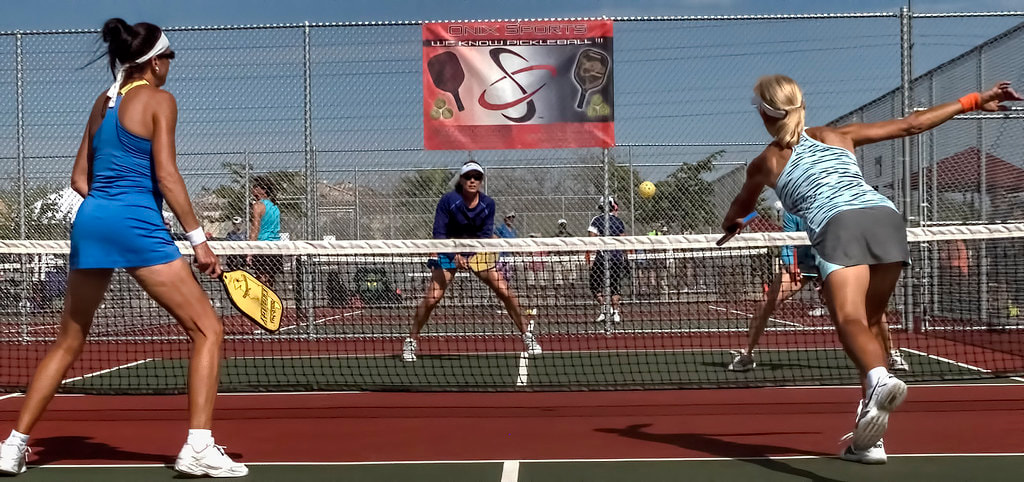
Mastering ball placement is critical for attaining higher levels in pickleball play. What factors determine where your ball will land?
1) The angle of your paddle (up and down & left and right)
2) The angle of your swing (up and down & left and right)
3) Your wrist movement, if any
4) The power behind your hit
5) Spin
Before you concentrate on ball placement, though, you must first consider how you contact the ball. Focus your attention and skills (such as good footwork and proper form with your stroke) to the contact of the ball. Only after this focus on ball contact should you consider how you place it on the court.
Take time to get into position early enough to take a proper backswing before hitting the ball. If that means halting in mid-court, so be it. Stop, prepare your swing, and focus on contacting the ball. Many players say you should think about “swinging through the ball,” as this makes
Now, let’s get back to the five elements that help you position the ball on the court.
1) The angle of your paddle (up/down & left/right)
Depending on the type of hit you want to make, you’ll need to angle your paddle properly. If the paddle face is too open, your shot may go too high—often a critical error when at the net. If it’s too closed, the ball may likely land in the net. Finding (and practicing) paddle angles to achieve the shot you want will help when you get to placing that shot.
2) The angle of your swing (up/down & left/right)
When you combine how open your paddle is with how you angle it left or right, you’re on the road to ball placement. The angle of your body also affects where your ball will land. Lots variables for a sport that is supposed to be simple!
3) Your wrist movement – if any
Most good players will tell you that keeping your wrist straight helps to make your shot go straight, so you should not put wrist action into your swing. Of course, for every rule, there are times when it should be broken. When you want to impart a pop to your swing at the last minute, you can snap your wrist at the moment your paddle contacts the ball. You can also use this technique to change its direction at the last minute, which can fool your opponent.
4) The power behind the hit
How much power you apply to your stroke will determine where the ball lands on the court. The length of your backswing, how much muscle you apply, and whether or not you follow through or “pop” the ball with a short stroke will change its distance. Learning how much power to use is a matter of practice.
Then we come to . . .
5) Spin
Spin is something that many players find difficult to handle. Learning to tell you’re your opponent has put spin on the ball takes practice, but once you can, the advantage can e yours if you know how to use that spin to your advantage.
When a ball with spin hits your paddle, the spin continues. The type of ‘original spin’ determines what direction the spin will take at the time of the hit.
When a ball with top spin hits your paddle, it continues spinning, but it bounces off with under spin. (The reverse is also true: a ball with under spin will bounce back with topspin.) Side spin works differently. A drive with left spin veers to your left, but when it bounces off your paddle, it veers to your right.
When your opponent sends a ball with spin, the best method of handling it is to continue the spin.
Returning a top spin shot by applying under spin maintains the momentum of the spin. You can perpetuate the spin of a right spin shot with right spin on your return (and left spin with more left spin).
If you apply an opposite spin when you hit the ball, the rotation of your spin will counter much of the original spin on the ball. Additionally, your shot will fly farther because its trajectory will be flatter.
If you return a spinning ball and add no spin of your own, the ball will maintain some of its rotation, and it will veer from your paddle in the direction of its spin. Therefore, a ball with top spin will travel upward from your paddle; a ball with under spin will travel downward. Keep this in mind, so you’re not surprised by a shot that goes higher, lower, or deeper than you expected. Note: continuing the momentum of a spin is easier than trying to counter it.
-----------------------------
There are many good resources in print and on the Web that explain these five elements in more detail. I’ll put in a plug for my own book, The Art of Pickleball, since I believe it does a good job of making them clear. To become skilled at pickleball so that your shots land where you want them to in an “effortless” manner takes practice, but that practice is easier when you understand the basics before you begin. Consider your options; be savvy about your returns. Take time to think through the fundamentals, and prepare for each shot. Once you start thinking like a pro, practice will help you play like a pro.

 RSS Feed
RSS Feed